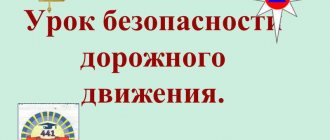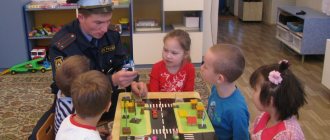Class hour on traffic rules for 5th grade
Class hour for 5th grade students
"Traffic Laws"
Lesson 1.
All people, as soon as they go outside, become pedestrians. A real pedestrian behaves confidently on the street, and drivers treat him with respect. Cars drive according to strict rules. There are also rules for pedestrians. If you don't know them, you will never become a good pedestrian.
Today, every schoolchild should know that the street is very dangerous for those who do not know how to walk along it correctly. But those who firmly know and strictly follow the strict traffic rules need not be afraid of the fastest car. Let's review these rules.
Rule 1:
Pedestrians should only walk on
the sidewalk.
And you need to walk along it, sticking to the right side, so as not to collide with oncoming people.
Rule 2:
if the road is small, pedestrians on the sides walk
towards traffic.
Rule 3:
When crossing the street, you must look first
to the left
and then
to the right.
Rule 4:
You can’t cross the road anywhere and anyhow!
Where can you cross the street? along pedestrian crossings.
Rule 5:
The “three-eyed street commander” traffic light helps you cross the road correctly at an intersection
.
Solve the crossword puzzle and remember the basic concepts of the road alphabet:
| 1) Striped horse, Its name is zebra. But not the one at the zoo. People keep walking along it. | 2) Kolya is rushing along the path in the yard on a horse. Not a car, not a moped, but a simple one. | 3) From the edge of the city to the other, a house walks under an arc. |
| 4) Not alive, but walking. Motionless, but leading. | 5) On the road to all the guys We have been shining for a long time, We are three siblings Our little house - | 6) A house is walking down the street, taking us to work. Not on chicken legs, but in rubber boots. |
| 7) To cross the road when the light is green, listen to our advice: - Wait! And you will see in front of him………light |  Along the side of the road they stand like soldiers. Along the side of the road they stand like soldiers.You and I all do everything they tell us to do. | 9) Cars rush through the streets, Tires rule there. We went down into the passage, the owner is there... |
| 10) To help you. The path is dangerous. Lights up day and night Green, yellow, ... | 11) You are waiting to board at a designated area, You don’t need any skill, This place... | 12) Doesn’t fly, doesn’t buzz. The beetle is running down the street. And two brilliant lights burn in the beetle’s eyes. The factory gave him this: And the lights to look into the darkness, And the wheels, and the engine, To rush at full speed. |
| 12 | |||||||||||
| 5 | |||||||||||
| 1. | 9 | ||||||||||
| 2. | |||||||||||
| 6 | 10 | ||||||||||
| 11 | |||||||||||
| 4 | 8 | ||||||||||
| 3. | 7 | ||||||||||
| O | With | T | O | R | O | and | n | O | With | T | b |
Lesson 2. Watch a video on traffic rules
https://www.youtube.com/watch?v=H1Hl-MS_qj0
Take the traffic rules test for schoolchildren:
| Question 1. The picture shows a certain situation. What should a pedestrian do? | ||
| Possible answers: A) give way to a vehicle B) cross the road in front of the car C) a motorist is obliged to give way to a pedestrian. | ||
| Question 2. The picture shows a certain situation. How should pedestrians cross the roadway? | ||
| Possible answers: A) anywhere there is a pedestrian crossing B) in front of and behind the traffic controller C) it is prohibited to cross the roadway | ||
| Question 3. The picture shows a certain situation. On which side of the traffic controller can you cross the roadway? | ||
| Possible answers: A) crossing the road is prohibited B) in front of and behind the traffic controller B) anywhere along the zebra crossing | ||
| Question 4. The picture shows a certain situation. When can you cross the road without the help of an underpass? | ||
| Possible answers: A) if there is no moving vehicle B) if pedestrians are in a hurry C) only through the underground passage and nothing else D) at your own discretion | ||
| Question 5: Where should you expect public transport? | Question 6. How to get around the tram correctly? | |
| Answer options: A) on the side of the road B) at a stop, if necessary, you can go out onto the roadway to see if traffic is approaching C) at a stop, you cannot go out onto the roadway D) in any place convenient for pedestrians | Possible answers: A ) only behind B) only in front C) it doesn’t matter, both answers are correct | |
| Question 7. The picture shows a road sign. What does it mean? | ||
| Possible answers: A) pedestrian traffic is prohibited B) pedestrian traffic is allowed B) pedestrian crossing | ||
| Question 8. Are pedestrians allowed to cross the roadway within the visibility range of a traffic light? | ||
| Possible answers: A) yes B) no C) only if there is no moving vehicle | ||
| Question 9. The picture shows a road sign. What does it mean? | ||
| Possible answers: A) in sections of the roadway where there are few cars, at right angles to the curb B) at intersections C) it doesn’t matter, both answers are correct | ||
| Question 10. The picture shows a situation. In which section of the roadway are pedestrians allowed to cross the road? | ||
| Answer options: A) 1 B) 2 AT 3 D) 4 D) 5 | ||
Lesson summary on life safety: “Road rules” (5th grade).
Lesson No. 32.
Topic: “Road rules. General provisions. Some terms"
The purpose of the lesson:
familiarity with the Rules of the Road, the terms used and the main provisions of the traffic rules.
Lesson type:
learning new material.
Presentation plan:
- Traffic Laws.
- Basic provisions. Terms.
Lesson objectives:
— familiarizing students with the basic provisions of the Traffic Rules,
— developing students’ skills in using the terminology of the Road Traffic Rules.
Materials for the lesson:
1. Traffic rules
Traffic rules (abbreviated: traffic rules) are a set of rules governing the responsibilities of vehicle drivers and pedestrians, as well as technical requirements for vehicles to ensure road safety.
The history of modern traffic rules originates in London. On December 10, 1868, a mechanical railway signal with a colored disc was installed on the square in front of Parliament. Its inventor, J.P. Knight, was a specialist in railway semaphores. The device was manually controlled and had two semaphore wings. The wings could take different positions: horizontal - a stop signal and lowered at an angle of 45 degrees - you can move with caution. With the onset of darkness, a rotating gas lamp was turned on, which gave signals in red and green light. A servant in livery was assigned to the semaphore, whose duties included raising and lowering the boom and turning the lantern. However, the technical implementation of the device turned out to be unsuccessful: the grinding of the lifting mechanism chain was so strong that passing horses shied away and reared up. Having not worked for even a month, on January 2, 1869, the semaphore exploded, and the policeman who was with it was injured.
The prototypes of modern road signs can be considered signs that indicated the direction of movement to a populated area and the distance to it. The decision to create uniform European traffic rules was made in 1909 at a world conference in Paris, due to the increase in the number of cars, speeds and traffic intensity on city streets. The next important step was the adoption of the “Convention for the Introduction of Uniformity in Road Signaling” in 1931 in Geneva, at the Road Traffic Conference, in which, among other countries, the Soviet Union took part.
COUNCIL OF MINISTERS - GOVERNMENT OF THE RUSSIAN FEDERATION
RESOLUTION
dated October 23, 1993 N 1090
ABOUT ROAD RULES
In order to ensure order and safety of road traffic, increase the efficiency of the use of road transport, the Council of Ministers - Government of the Russian Federation decides:
1. Approve the attached Traffic Rules of the Russian Federation and the Basic Provisions for the admission of vehicles to operation and the responsibilities of officials to ensure road safety (hereinafter referred to as the Basic Provisions) and put them into effect from July 1, 1994.
The republics within the Russian Federation, territories, regions, autonomous regions, autonomous okrugs, the cities of Moscow and St. Petersburg shall ensure the organization of traffic on streets and roads in accordance with the requirements of the Traffic Rules of the Russian Federation.
2. Ministries and departments, before July 1, 1994, bring regulations into compliance with the Traffic Rules of the Russian Federation and the Basic Provisions.
3. In 1994, the Ministry of Internal Affairs of the Russian Federation and the Ministry of Defense of the Russian Federation should develop a procedure for admitting military drivers to transport people in trucks.
4. To the Ministry of Press and Information of the Russian Federation:
ensure the publication in sufficient quantities of the Road Traffic Rules of the Russian Federation, the Basic Provisions, as well as, in agreement with the Ministry of Internal Affairs of the Russian Federation and the Ministry of Transport of the Russian Federation, a collection of regulations on road traffic issues;
together with the Ministry of Education of the Russian Federation and the Ministry of Internal Affairs of the Russian Federation, ensure the publication of educational and methodological literature and visual aids to popularize the Traffic Rules of the Russian Federation and the Basic Provisions.
5. In 1993, the Committee of the Russian Federation for Standardization, Metrology and Certification, together with the Ministry of Internal Affairs of the Russian Federation, introduced new road signs into state standards regulating the procedure for the movement of vehicles transporting dangerous goods.
2. General provisions.
1.1. Traffic rules establish a uniform procedure for road traffic throughout the Russian Federation. Other regulations relating to road traffic must be based on the requirements of the Rules and not contradict them.
1.2. The Rules use the following basic concepts and terms:
"Motorway"
— road marked with sign 5.1.
"Bike"
- a vehicle, other than wheelchairs, that has two or more wheels and is driven by the muscular power of the people on it.
"Driver"
- a person driving a vehicle, a driver leading pack animals, riding animals or a herd along the road. A driving instructor is treated like a driver.
"Forced stop"
- cessation of movement of a vehicle due to its technical malfunction or danger created by the cargo being transported, the condition of the driver (passenger) or the appearance of an obstacle on the road.
"The main road"
- a road marked with signs 2.1, 2.3.1 - 2.3.3 or 5.1, in relation to the one being crossed (adjacent), or a road with a hard surface (asphalt and cement concrete, stone materials, etc.) in relation to a dirt road, or any road in relation to exits from adjacent territories. The presence of a paved section on a minor road immediately before the intersection does not make it equal in importance to the one it intersects.
"Road"
- a strip of land or a surface of an artificial structure equipped or adapted and used for the movement of vehicles. The road includes one or more carriageways, as well as tram tracks, sidewalks, shoulders and dividing strips, if any.
"Traffic"
- a set of social relations that arise in the process of moving people and goods with or without vehicles within the boundaries of roads.
"Traffic Accident"
- an event that occurred during the movement of a vehicle on the road and with its participation, in which people were killed or injured, vehicles, structures, cargo were damaged, or other material damage was caused.
"Railroad crossing"
— intersection of the road with the railway tracks at the same level.
"Route vehicle"
- a public vehicle intended for transporting people on roads and moving along a set route with designated stopping points (stops).
"Mechanical vehicle"
- a vehicle, other than a moped, driven by an engine. The term also applies to any tractors and self-propelled machines.
"Moped"
- a two- or three-wheeled vehicle driven by an engine with a displacement of not more than 50 cubic meters. cm and having a maximum design speed of no more than 50 km/h. Bicycles with a suspended engine, mopeds and other vehicles with similar characteristics are considered mopeds.
"Motorbike"
- a two-wheeled motor vehicle with or without a side trailer. Three- and four-wheeled mechanical vehicles with a curb weight of no more than 400 kg are considered motorcycles.
"Locality"
- a built-up area, the entrances to and exits from which are marked with appropriate signs.
"Lack of Visibility"
— road visibility is less than 300 m in conditions of fog, rain, snowfall, etc., as well as at dusk.
"Overtaking"
— advance of one or more moving vehicles associated with leaving the occupied lane.
"Dangerous Cargo"
- substances, products made from them, waste from industrial and other economic activities, which, due to their inherent properties, can pose a threat to human life and health during transportation, harm the natural environment, damage or destroy material assets.
“Organized transportation of a group of children”
- special transportation of two or more children of preschool and school age, carried out in a mechanical vehicle other than a route vehicle.
"Organized transport convoy"
- a group of three or more motor vehicles following directly after each other along the same lane with their headlights constantly on, accompanied by a lead vehicle with a blue flashing light or blue and red beacons on.
"Organized foot column"
- a group of people designated in accordance with paragraph 4.2 of the Rules, moving together along the road in the same direction.
"Stop"
- deliberately stopping the movement of a vehicle for up to 5 minutes, as well as for longer if this is necessary for boarding or disembarking passengers or loading or unloading a vehicle.
"Passenger"
- a person, other than the driver, who is in the vehicle (on it), as well as a person who enters the vehicle (gets on it) or leaves the vehicle (gets off it).
"Crossroads"
- a place of intersection, junction or branching of roads at the same level, limited by imaginary lines connecting, respectively, the opposite, most distant from the center of the intersection, beginnings of curvatures of roadways. Exits from adjacent areas are not considered intersections.
"A pedestrian"
- a person who is outside the vehicle on the road and does not perform work on it. Persons moving in wheelchairs without a motor, driving a bicycle, moped, motorcycle, carrying a sled, cart, baby stroller or wheelchair are considered pedestrians.
"Crosswalk"
- a section of the roadway designated for the movement of pedestrians across the road.
"Lane"
- any of the longitudinal stripes of the roadway, marked or not marked with markings and having a width sufficient for the movement of cars in one row.
"Advantage (priority)" -
the right to priority movement in the intended direction in relation to other road users.
"Adjacent territory" -
territory directly adjacent to the road and not intended for through traffic of vehicles (yards, residential areas, parking lots, gas stations, enterprises, etc.).
"Trailer"
- a vehicle not equipped with an engine and intended to be driven in conjunction with a power-driven vehicle. The term also applies to semi-trailers and trailers.
"Roadway"
- a road element intended for the movement of trackless vehicles.
"Dividing strip"
- a structurally separated element of the road that separates adjacent roadways and is not intended for the movement or stopping of trackless vehicles and pedestrians.
"Permitted maximum weight"
— the mass of the equipped vehicle with cargo” by the driver and passengers, established by the manufacturer as the maximum permissible. The permissible maximum mass of a vehicle composition, that is, coupled and moving as one unit, is taken to be the sum of the permissible maximum masses of the vehicles included in the composition.
"Adjuster"
- a person vested in the prescribed manner with the authority to regulate traffic with the help of signals established by the Rules, and who directly carries out the said regulation. The traffic controller must be in uniform and (or) have a distinctive sign and equipment. Traffic controllers include police officers and military automobile inspectors, as well as employees of road maintenance services, those on duty at railway crossings and ferry crossings when performing their official duties.
"Parking"
- intentional stopping of the movement of a vehicle for a period of more than 5 minutes for reasons not related to the embarkation or disembarkation of passengers or the loading or unloading of the vehicle.
"Night time"
- the period of time from the end of evening twilight to the beginning of morning twilight.
"Vehicle"
- a device intended for the transport on roads of people, goods or equipment installed on it.
"Sidewalk"
- an element of the road intended for pedestrian traffic and adjacent to the roadway or separated from it by a lawn.
“Give way (do not interfere)”
- a requirement meaning that a road user must not start, resume or continue moving, or perform any maneuver if this may force other road users who have priority over him to change direction or speed.
"Road user" -
a person directly involved in the movement process as a driver, pedestrian, or passenger of a vehicle.
1.3. Road users are required to know and comply with the relevant requirements of the Rules, traffic lights, signs and markings, as well as comply with the orders of traffic controllers acting within the limits of the rights granted to them and regulating traffic with established signals.
1.4. Right-hand traffic for vehicles is established on the roads.
1.5. Road users must act in such a way as not to create a traffic hazard or cause harm.
It is prohibited to damage or pollute road surfaces, remove, block, damage, or unauthorizedly install road signs, traffic lights and other technical means of traffic management, or leave objects on the road that interfere with traffic. The person who created the obstacle is obliged to take all possible measures to eliminate it, and if this is not possible, then by available means ensure that traffic participants are informed about the danger and inform the police.
1.6. Persons who violate the Rules are liable in accordance with current legislation.
Questions for consolidation:
- What is a traffic lane?
- What is the purpose of the roadway?
- Who becomes a participant in the movement and in what cases?
- What is a sidewalk for?
Homework:
Answer the questions:
1. On which side of the road do cars move?
2. At what speed can you drive a car through a populated area?
Literature:
Traffic Laws.






